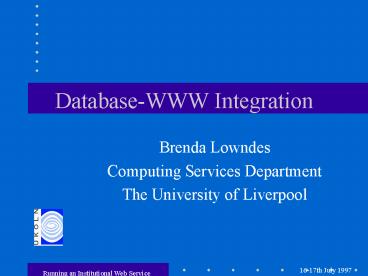DatabaseWWW Integration - PowerPoint PPT Presentation
Title:
DatabaseWWW Integration
Description:
Using the information in a database to create Web pages ... can be closed by a request or timed out after a defined period of inactivity or ... – PowerPoint PPT presentation
Number of Views:36
Avg rating:3.0/5.0
Title: DatabaseWWW Integration
1
Database-WWW Integration
- Brenda Lowndes
- Computing Services Department
- The University of Liverpool
2
Database-WWW Integration
- What is Database-WWW Integration?
- Why integrate a database with the Web?
- How is data integrated?
- What tools are available?
3
What is Database Integration?
- Using the information in a database to create Web
pages - Using a Web browser to access data in a database
4
Why Use a Database to Produce Web Pages?
- Institutional data is usually stored in a
database. - Data is being replicated in HTML pages
- Duplication of data and effort
- Inconsistencies in the data
- Difficult to merge updates
- Web pages can be updated automatically whenever
the database is updated
5
Why Use the Web to Access Data?
- Familiar interface
- Data can be integrated with other information in
an institutions web pages - Platform and vendor independent front-end
- Client machine does not need database
networking software - Information can be made available to anyone on
the Internet
6
Using a Web Browser to Access a Database
- Web pages and forms are used to provide access to
the database - Database can be queried or updated
7
How is Data Accessed?
- Relational Databases
- HTML pages are generated from the database
- statically
- dynamically
- Java and JDBC downloaded and run on the client
machine or on the server - Library catalogues, Z39.50 servers, other free
text search and retrieve
8
Static Access
- A program runs offline to produce the HTML pages
- Pages copied into web server directories
- Can be automated and scheduled to run
- at specific times
- triggered by a database update
9
Producing Static HTML Pages
- Any program that can access the database and
output HTML - programming language and embedded SQL
- report writers
- database scripting language
- Database and Web development software provides a
Save as HTML option.
10
When should you use Static Access?
- Non volatile data
- Fixed or small number of pages
- Predefined requests to the database
- No ad-hoc queries
11
Dynamic Access
- HTML pages are generated from the database when
the page is requested - Data always up to date
- HTML forms can be used to define specific data
that is to be retrieved - Many different pages can be generated
12
Pages are created by
- Running a simple program on the server which
outputs HTML - Extensions to the server which embed data
extracted from the database into an HTML template
file - Server-side scripts which access the database and
output HTML
13
Using a Program on the Server
- Typically a series of print statements that
output the whole HTML page - Usually run as a cgi program
- Written using
- DBPerl
- Embedded SQL
- DBMS report writers
- DBMS scripting language
14
Running a Program
HTML
15
Running a Program
HTML
Client/server Access
16
Running a Program
Database Networking Software
HTML
Database Client
Database Networking Software
17
Running a Program
CGI
ODBC Driver
HTML
Database Networking Software
Database Networking Software
18
Template Files
- Template specifies
- where the database is
- what data is required
- what HTML is output
- Process can be server filter or extension, plug
in or cgi script
19
HTML Templates
HTML Template
Server Extension
HTML
Database Networking Software
20
Internet Database Connectivity
- Microsofts IDC is an extension of their Internet
Information Server - Uses two files
- .IDC file provides information about the database
and the SQL queries used - .HTX file provides the HTML template into which
the data from the database is embeddded
21
Advantages of Using Templates
- Pages easier to write than full programs
- Requires only a knowledge of HTML and how to
specify an SQL query - Web development tools from Microsoft and other
suppliers often automate the process
22
Internet Database Connectivity
- Microsofts database products have wizards to
produce IDC/HTX files automatically - Microsofts Web development software -Frontpage,
Visual Interdev etc will generate IDC/HTX files - Web development tools from other suppliers will
also generate IDC/HTX files
23
Server-side Scripts
Active Page
Filter
HTML
Client/Server
24
Active Server Pages
- Microsoft Internet Information Server 3.0
- Server-side execution environment
- Can access any ODBC database
- Output is HTML- suitable for any browser
- Maintain a connection to the database
25
Stateless Connection
- Previous access methods do not maintain a session
between the server and the database - The client requests the data
- The server
- connects to the database
- produces the HTML
- delivers the page to the client
- disconnects from the database
26
Maintaining a Connection
- Many servers now can maintain a session between
subsequent requests from the client - These servers can maintain a connection to the
database - Can define a record set and scroll through
records - Database connection can be closed by a request
or timed out after a defined period of inactivity
or when the server is shut down
27
Java and JDBC
- JDBC is a Java API for executing SQL statements
- JDBC statements in a Java applet are used to
access virtually any relational database - The Java applet is downloaded to the client
- The client establishes the connection with the
database server
28
Java and JDBC
Java Applet
29
Java and JDBC
Web Server
Java Applet
Java Applet
Java JDBC
Java Applet
30
What Tools are Available?
- See http//www.liv.ac.uk/qq48/publications/html/
dbweb.html































